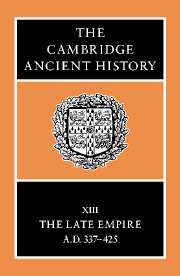
-
Select format
-
- Publisher:
- Cambridge University Press
- Publication date:
- March 2008
- December 1997
- ISBN:
- 9781139054409
- 9780521302005
- Dimensions:
- (231 x 158 mm)
- Weight & Pages:
- 1.6kg, 905 Pages
- Dimensions:
- Weight & Pages:
- Subjects:
- Ancient History, Classical Studies
- Collection:
- Cambridge Histories - Ancient History & Classics
- Series:
- The Cambridge Ancient History
You may already have access via personal or institutional login- Subjects:
- Ancient History, Classical Studies
- Collection:
- Cambridge Histories - Ancient History & Classics
- Series:
- The Cambridge Ancient History
Book description
With the publication of Volume 13 The Cambridge Ancient History moves into fresh territory. The first edition was completed by Volume 12 which closed in AD 324. The editors of the new edition have enlarged the scope of Volume 12 to include the foundation of Constantinople and the death of Constantine, and extended the series with two new volumes taking the history down to AD 600. Volume 13 covers the years 337–425, from the death of Constantine to the reign of Theodosius II. It begins with a series of narrative chapters, followed by a part on government and institutions. The economy and society of the Empire are grouped together, as are chapters on foreign relations and the barbarian world. A part on religion marks the importance of Christianity in the Roman Empire by this period. The volume concludes with chapters on the various literary cultures of the Empire, and on art.
Reviews
‘I had bought this volume before I was asked to review it, the best possible compliment surely to publishers, editors, and contributors alike.’
Source: The Classical Review
‘Cameron and Garnsey deserve congratulations for this: the volume will last at least as long as the first editions of CAH did (of course they did not cover this period at all), and maybe longer.’
Source: Journal of Roman Studies
Contents
Metrics
Altmetric attention score
Full text views
Full text views help Loading metrics...
Loading metrics...
* Views captured on Cambridge Core between #date#. This data will be updated every 24 hours.
Usage data cannot currently be displayed.
Accessibility standard: Unknown
Why this information is here
This section outlines the accessibility features of this content - including support for screen readers, full keyboard navigation and high-contrast display options. This may not be relevant for you.
Accessibility Information
Accessibility compliance for the PDF of this book is currently unknown and may be updated in the future.


